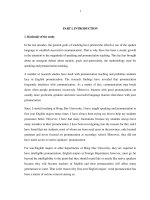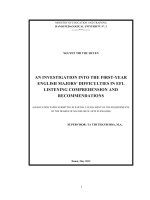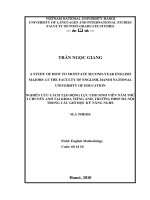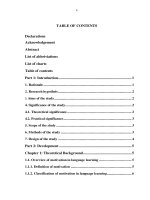Some common listening problems of can tho university first year english majors and some suggestions
Bạn đang xem bản rút gọn của tài liệu. Xem và tải ngay bản đầy đủ của tài liệu tại đây (629.15 KB, 62 trang )
CAN THO UNIVERSITY
SCHOOL OF EDUCATION
ENGLISH DEPARMENT
SOME COMMON LISTENING PROBLEMS OF CAN THO
UNIVERSITY FIRST-YEAR ENGLISH-MAJORS AND
Trung tâm Học liệu ĐHSOME
Cần SUGGESTIONS
Thơ@Tài liệu học tập và nghiên cứu
B.A. Thesis
Supervisor: Trần Thị Sáu M.A
Student: Nguyễn Kim Thảo
Student code: 7032577
Class: NN0354A4
Course: 29
Can Tho, June 2007
Some common listening problems Can Tho University first-year
Trung tâm Học liệu ĐH Cần Thơ@Tài liệu học tập và nghiên cứu
English-majors often have and some suggestions
ACKNOWLEDGEMENTS
This work would not have been possible without the assistance provided by many people.
So, I would like to send my sincere thanks to Ms. Tran Thi Sau, my thesis supervisor, for her
enthusiasm and vision throughout this thesis; Mr. Dao Minh Trung for his many useful feedback
as second-reader; Mr. Huynh Van Hien for his encouragement for fulfillment of this thesis; Mr.
Trinh Quoc Lap and Mr. Tran Minh Tuan for their useful help with performing descriptive
statistical analysis in SPSS and also for their support for this thesis; Mr. Huynh Trung Nghia,
Ms. Nguyen Thi Anh Tho, Mr. Daniel James White and their classes for their fully devoted
cooperation in this thesis for data collection. My family and my friends – thanks for the support,
sacrifice and putting up with me during all this. Errors and omissions that remain are, of course,
mine alone.
Trung tâm Học liệu ĐH Cần Thơ@Tài liệu học tập và nghiên cứu
i
TABLE OF CONTENTS
TABLE OF CHARTS AND FIGURES....................................................................................v
NOMENCLATURE / LIST OF ABBREVIATIONS .............................................................vi
ABSTRACT .................................................................................................................................1
CHAPTER 1
INTRODUCTION .......................................................................................................................3
1.1. Rationale.................................................................................................................................3
1.1.1. Background...................................................................................................................3
1.1.2. Personal-Experience ....................................................................................................4
1.2. Research question and research aims .................................................................................5
1.3. Thesis organization ...............................................................................................................6
CHAPTER 2
Trung tâm Học liệu ĐH Cần Thơ@Tài liệu học tập và nghiên cứu
LITERATURE REVIEW...........................................................................................................7
2.1. Definition of listening ...........................................................................................................7
2.2. Kinds of listening ...................................................................................................................8
2.3. Definition of a problem .........................................................................................................10
2.4. Definition of listening problem ............................................................................................11
2.5. Common kinds of listening problems ..................................................................................12
2.5.1. Study strategies .............................................................................................................11
Mother tongue influence ........................................................................12
Word-by-word listening and word-by-word taking note ......................12
Closed-mindedness listen........................................................................13
ii
2.5.2. Psychological base .......................................................................................................14
Intellectual despair .....................................................................................14
False attention ............................................................................................14
Stress ............................................................................................................15
2.2.3. Physiological base ........................................................................................................15
2.2.4. Linguistic knowledge ...................................................................................................16
CHAPTER 3
METHODOLOGY ......................................................................................................................17
3.1. Design ...............................................................................................................................17
3.2. Participants and Context ................................................................................................17
3.3. Data collection techniques and procedure....................................................................19
Trung tâm
liệu
ĐH Cần
Thơ@Tài
liệu ..............................................
học tập và nghiên19cứu
Học
Recorded
Interviews
with teachers
and students
Questionnaires for students ................................................................................19
Classroom observation ........................................................................................20
CHAPTER 4
RESULTS......................................................................................................................................21
4.1. Questionnaires analysis .....................................................................................................22
4.1.1. The importance of solving listening problems ....................................................22
4.1.2. Common kinds of listening problems ..................................................................23
4.2.3. Solutions for listening problems ...........................................................................26
iii
4.2. Interview analysis ...............................................................................................................27
4.2.1. The importance of solving listening problems ....................................................27
4.2.2. Common kinds of listening problems ..................................................................27
4.3. Observation analysis ..........................................................................................................28
CHAPTER 5
DISCUSSION AND IMPLICATIONS.....................................................................................29
5.1. Discussion...............................................................................................................................29
5.1.1. Research question ....................................................................................................29
5.1.2. Research aim ............................................................................................................30
5.1.3. Some suggestions for listening problems................................................................30
5.1.3.1. Study strategies .............................................................................................31
Mother tongue influence ..............................................................................31
Word-by-word listening and note taking .....................................................31
Closed-mindedness listen ..............................................................................31
Trung tâm Học liệu ĐH Cần Thơ@Tài liệu học tập và nghiên cứu
5.1.3.2. Psychological and physiological base.........................................................32
Intellectual despair and False attention ......................................................32
Stress ...............................................................................................................33
5.1.3.3. Linguistic base ..............................................................................................33
5.2. Limitation ...............................................................................................................................34
5.3. Suggestions .............................................................................................................................34
iv
CHAPTER 6
CONCLUSION ............................................................................................................................35
APPENDICES ..............................................................................................................................36
Appendix A: Questionnaire (English) ...........................................................................36
Questionnaire (Vietnamese) .....................................................................39
Appendix B: Observation Sheet .....................................................................................42
Appendix C: Questions For Interview ........................................................................... 45
PROTOCOL ................................................................................................................................46
REFERENCES ............................................................................................................................50
Trung tâm Học liệu ĐH Cần Thơ@Tài liệu học tập và nghiên cứu
v
LIST OF CHARTS, TABLES AND FIGURES
Figure 1: Bottom-up vs. top-down processing, a brick-wall analogy ......................................9
Figure 2: The policy cycle.............................................................................................................10
Chart 1: The importance of solving listening problems ..............................................................22
Table 1: Reliability Statistics of Questionnaires .........................................................................23
Table 2: Descriptive statistics of general listening problems.....................................................23
Chart 2: The comparative of kinds of listening problems ...........................................................24
Table 3: Descriptive statistics of kinds of listening problems ....................................................25
Chart 3: The comparative between kinds of listening problems solutions ................................26
Trung tâm Học liệu ĐH Cần Thơ@Tài liệu học tập và nghiên cứu
vi
NOMENCLATURE / LIST OF ABBREVIATIONS
CTU
Can Tho University
SLA
Second Language Acquisition
SD
Standard Deviation
L1
Native language
L2
Foreign language
VN
Vietnam
Trung tâm Học liệu ĐH Cần Thơ@Tài liệu học tập và nghiên cứu
vii
Trung tâm Học liệu ĐH Cần Thơ@Tài liệu học tập và nghiên cứu
Listening problems and solutions
ABSTRACT
From the result of this descriptive research, the majority of CTU first-year English
majored students tend to have ―Study strategies‖ and ―Linguistic base‖ listening problems.
Certainly, they tend to slightly reject ―Psychological base‖ and ―Physiological base‖ problems.
Besides, their most favorable solutions are ―Basing on what they can listen to and guessing what
is unsaid and the speaker bias‖; ―Skipping unknown lexical terms, which makes them panic, and
try to listen to the next useful passage‖; and ―Keeping calm and take notes for the main ideas‖.
Other solutions seem to get less attention. The controlling idea of this paper is about ―some
common listening problems of CTU first year English-majors (course thirty two)‖, namely
―study strategies‖, ―psychological base‖, ―physiological base‖ and ―linguistic base,‖ based on
some well known listening problems research. Moreover, some solutions of were also
recommended; students typically sought such solutions to their problems on their own accord.
Trung tâm Học liệu ĐH Cần Thơ@Tài liệu học tập và nghiên cứu
The instruments employed are questionnaires with the participation of 140 students, recoded
interviews with 4 experienced teachers and observation of 4 academic listening periods. Analysis
of the data focuses on questionnaires that categorized common listening problems and some
solutions, episodes from the recorded interviews to explore the teachers‘ views and experiences
about this matter. In short, the matter is to train good listeners, we should take a close look to this
matter i.e. consider those most common listening problems to have the suitable solutions.
1
Listening problems and solutions
‗Nature has given us one tongue, but two ears, that we
may hear from others twice as much as we speak!‘
Epictetus
‗Listening is an art and a gift‘
Carol J. Evans
‗Listening is Cinderella skill in second language
learning‘
Nunan. D
Trung tâm Học liệu ĐH Cần Thơ@Tài liệu học tập và nghiên cứu
2
Listening problems and solutions
CHAPTER 1
INTRODUCTION
1.1. Rationale
"Nature has given us one tongue, but two ears, that we may hear from others twice as
much as we speak!" (Epictetus, n.d.). Listening is not only an essential tool in class but also an
active process to everyone‘s success in daily real-life communication. Regardless of whether a
person is a student, a boss, or an employee, most of us have never considered this matter
carefully.
Also, Evans believed that ―Listening is an art and a gift‖ (Carol J. Evans, 1999).
Essentially, listening is an integral skill, but studying it is a big obstacle. Almost all of Englishmajored students listen poorly since they concentrate more on themselves than on what other
Trung tâm Học liệu ĐH Cần Thơ@Tài liệu học tập và nghiên cứu
people are telling them. In this research, student researcher have stated a lot of information about
listening problems and some solutions with the hope that my work will be useful for anyone that
would like to improve their English listening skills.
1.1.1. Background
Listening is not only an essential tool for communication, but also an active process to
everyone‘s success in interaction. In many circumstances, for instance at work, it is required to
collaborate with each other in order to solve problems. For having a successful collaboration, it
is most important to listen and understand what others say and interpret their opinions (Diana &
Simon, 1996). When listening in daily life, one usually has a general idea about someone who is
3
Listening problems and solutions
speaking and what they are talking about. In contrast, when listening to a recording in class,
integration of listening and understanding might be not always the case.
In the same way, interpreting context is not often a problem for CTU English-major
freshmen in normal communication when they are usually involved in the dialogue. However,
listening to recorded materials in the classroom or during exams especially requires learners to
understand the context of the listening extracts. Thus, they tend to have a lot of problems when
listening to a recorded passage.
Listening plays a major role in our life and study, however almost all of the students have
substantial difficulties with this kind of skill (Henry L. Roediger, 2004). For improvement of
listening skills, there is a need to identifying these problems. In this research, I stated a lot of
information about listening problems and some solutions in the hope that my work will be useful
for anyone that would like to improve their English listening skills.
Trung tâm Học liệu ĐH Cần Thơ@Tài liệu học tập và nghiên cứu
1.1.2. Personal-Experience
Listening is an integral skills, and studying English for Vietnamese native students is a big
obstacle. For my personal-experience, although Can Tho University (CTU) English-majored
students are not very good at listening skills in comparison with other issues, such as reading,
writing and speaking in Second Language Acquisition (SLA), listening problems and their
solutions seem to be of less interest. As an English-majored student, I especially would like to
investigate this matter for three reasons. First of all, as we know, listening is an important skills
for everyone in an everyday aspect, having a deeper look at listening skills is necessary. Not only
would this work help us to increase our listening ability, but it would also create a convenient
environment for self-training in listening. The second reason is that, as in the case of many other
4
Listening problems and solutions
English-majored students, I have had a lot of problems with listening, particularly listening to
recorded messages during lessons and exams. I have deliberated with myself about these
ambiguous problems until I decided to consider this matter more seriously, i.e. effectuating this
research. Finally, I would like to carry this survey on CTU first year English majored students
with the hope that I can find out their actual listening problems and subsequent solutions. From
to the results of this survey, I will find out their common listening problems and some suitable
solutions for this issue. All in all, the confusion cited by various SLA researchers in the field of
listening problems and my own experiences lead me to the implementation of this thesis.
1.2. Research question and research aims
My research will answer the question: ―What are common listening problems that first
year English-majored students often have?‖ and my research aim is to find out some suitable
solutions for these listening problems.
Trung tâm Học liệu ĐH Cần Thơ@Tài liệu học tập và nghiên cứu
For this research, I read a lot of research articles and books discussing about common
listening problems those students who study English as a foreign language usually have. These
problems are very similar to those that CTU English-majors have. Thus, my research had two
aims:
In the short-term, my aim is to investigate the common listening problems that CTU firstyear English-majors usually experience and my suggestions for improvement on this matter.
Secondly, the long-term aim is to find the most helpful ways for learners who study English as a
second language to avoid these mistakes.
5
Listening problems and solutions
1.3. Thesis organization
This thesis is organized into six chapters. The first chapter is the introduction, which explains
to readers the rationale for the thesis implementation; the thesis states what the student researcher
as well as readers of different pedagogical status are assumed to achieve upon involvement with
this papers.
The literature review is the content of chapter two, which brings about a variety of
viewpoints hypothesized and tested by first-class SLA experts and researchers, not only to give
the thesis a theoretical base and state some assumptions, but to make it objective as well.
Chapter three is methodology, which outlines a description of how this survey was carried
out.
The results are the content of chapter four, ascertaining the students‘ listening problems from
the synthesis of data collected.
Trung tâm Học liệu ĐH Cần Thơ@Tài liệu học tập và nghiên cứu
After the results are brought up, an analysis and a discussion (Chapter five) follow to
compare and contrast the results from the points of view cited in the literature review and
obtained from some observations and interviews with the participants. The chapter also includes
some implications for both teachers and students, and some limitations of this study.
Finally, conclusion (chapter six) has been generalized for the whole paper and for further
research on this issue.
6
Listening problems and solutions
CHAPTER 2
LITERATURE REVIEW
2.1. Definition of listening
Listening is the process of understanding what was meant; not simply sensing what was said.
When you listen, according to Webster‘s New World Dictionary, you ―make a conscious effort
to hear‖. Listening takes effort, in the contrast, hearing is simply an automatic reaction of being
aware of sounds with your ears. Furthermore, listening is one of the things people do most of the
time in a day; the average person spends 9% of his daily communication time writing, 16%
reading, 30% speaking and a whopping 45% listening. Students spend most of their school time
listening up to 60% (Wycoff, Schaffer & McCutcheon, 1994).
Listening is not only a major skill in English study, but it also plays an important role in
Trung
Cần Thơ@Tài
liệu học
và nghiên
everydaytâm
life Học
aspects,liệu
suchĐH
as business,
daily communication,
andtập
language
teaching cứu
and
learning, etc. Listening is a complex process in which you can understand speaking; moreover, it
is a ―critical means of acquiring a second language‖ (Rost, 2001). Listening plays a rather major
role in terms of all English study skills. When a human is born and knows nothing. They learn to
speak by imitating whatever their parents say to them. They listen first, recording the sounds in
the brain, and then transfer it into speech (Henry L. Roediger, 2004); as is an English-majors
study process. Thus, how well a person speaks may depend heavily on the person‘s previous
experience on listening. In short, ―Listening is thus fundamental to speaking‖ (Rost, 1994).
According to Nancy (1999), listening is an art, not a science. From her research, readers can see
the importance of listening in a successful business. Also, Fortune magazine rated listening as
the top management skill needed for success in business (Wycoff, Schaffer & McCutcheon,
7
Listening problems and solutions
1994). These bases lead us to have a closer look at listening and how listening is worthwhile for
every one in every country in their daily life aspects.
2.2. Kinds of listening
Understanding the major role of listening in study and daily life aspects, everyone would like
to posses this skill. However, depends on which aspects, which kinds of listening, students may
have different methods for training.
Depending on the type of text being listened to, Anderson and Lynch (1988) classified
listening into two kinds reciprocal and non-reciprocal. Reciprocal listening refers to those
listening tasks where there is the opportunity for the listener to interact with the speaker, and to
negotiate the content of the interaction. Non-reciprocal listening refers to tasks such as listening
to the cassette player, radio or a formal lecture where the transfer of information is in one
directiontâm
only, Học
i.e. from
the speaker
to the Thơ@Tài
listener.
Trung
liệu
ĐH Cần
liệu học tập và nghiên cứu
While reciprocal listening requires the listener to take part in the interaction, non-reciprocal
listeners have to hear monologue, either live or through the media, have no opportunity of
answering back, clarifying understanding, or checking that they have comprehended correctly. In
the real world, it is rare for the listener to be cast in the role of non-reciprocal on a conversation.
However, in the listening classroom, this is the normal and common role (Ni Deng, 2006).
Besides, depending on ways of listening process, there are two types of listening i.e. the
bottom-up processing and the top-down interpretation. (Figure 1)
The bottom-up processing model assumes that listening is a process of decoding the sounds
that one hears in a linear fashion, from the smallest meaningful units (phonemes) to complete
8
Listening problems and solutions
texts. According to this view, phonemic units are decoded and linked together to form words,
words are linked together to form phrases, phrases are linked together to form utterances, and
utterances are linked together to form complete meaningful texts. In other words, the process is a
linear one, in which meaning itself is derived as the last step in the process. In ―The introduction
to listening‖, Anderson and Lynch (1988) call this the "listener as tape-recorder" view of
listening because it assumes that the listener takes in and stores messages sequentially, in much
the same way as a tape-recorder; one sound, word, phrase, and utterance at a time.
The alternative, top-down view, suggests that the listener actively constructs (reconstructs)
the original meaning of the speaker using incoming sounds as clues. In this reconstruction
process, the listener uses prior knowledge of the context and situation within which the listening
takes place to make sense of what he or she hears. Context of situation includes such things as
knowledge
of the
topicliệu
at hand,
speakers,
and their relationship
the situation
as well ascứu
to
Trung
tâm
Học
ĐHtheCần
Thơ@Tài
liệu họcto tập
và nghiên
each other and
prior events.
LIFE
EXPERIENCE
TOP-DOWN
ACTIVATION
STRUCTURES
VOCABULARY
BOTTOM-UP
Figure 1: Bottom-up vs. top-down processing, a brick-wall analogy
(Marc H. & Steven B., 1995)
In general, in this research, I work on the non-reciprocal listening (tape recording) and discover
how the process of listening (bottom-up or top-down) affects students‘ listening ability.
9
Listening problems and solutions
2.3. Definition of a problem
According to Bacon (1913), a problem is a question proposed for solution or a matter
stated for examination or proof; hence, a problem is a matter difficult of solution or settlement; a
doubtful case; a question involving doubt. Another researcher stated that a problem is anything
which is required to be done: as, in geometry, to bisect a line or to draw a perpendicular; or, in
algebra, to find an unknown quantity (Math, 1913). In other words, a problem is something to be
done, as to bisect a triangle, to describe a circle. In another field like plane problem, Geom
definited a problem is what can be solved by the use of the rule and compass, and a problem
requires in its geometric solution the use of a conic section or higher curve.
Language is any means of conveying or communicating ideas; specifically, human
speech, the expression of ideas by the voice, sounds, expressive of thought, articulated by the
organs of the throat and mouth. So, in the language field, a problem means a communicating
Trung tâm Học liệu ĐH Cần Thơ@Tài liệu học tập và nghiên cứu
matter difficult for solution or settlement (Webster, 1913).
Whenever problem has been occured, people
usually solve it by carrying out this policy
Identify
problem
cycle. (Figure 2)
Set
agenda
Suggest
changes
According to this policy cycle (Carla,
2003), if there is any problem identified,
Develop
proposals
Evaluate
results
people should chronologically set the agenda,
organize
Build
support
Implement
policy
stakeholders,
choose
tactics,
aggregate related issues, and legitimate (or de-
Enact law
or rule
legitimate) issues. Next, develop proposals for
Figure 2: The policy cycle
preferred policy options. Proponents build
10
Listening problems and solutions
support through public education of decision makers, enacting into law or rule, implementing
policy, evaluating result and suggesting changes are those last steps for a problem solving. In
short, this is one of the effective solution for any problem in any field of study.
2.4. Definition of listening problem
Listening is Cinderella skill in second language learning i.e. it has been overlooked by its
elder sister: speaking. For most people, being able to claim knowledge of a second language
means being able to speak and write in that language. Listening and reading are therefore
secondary skills; a means to other ends, rather than ends in them. (Nunan, 1997)
Underwood (1989:1) believes that listening is an essential skill for successful
communication, and a skill, which seems to develop easily for native speakers but requires
considerable effort where listening in a foreign language is concerned. In other words, listening
Trung tâm Học liệu ĐH Cần Thơ@Tài liệu học tập và nghiên cứu
is probably the least explicit of the four macro-language skills i.e. listening, speaking, reading,
writing, making it the most difficult skill to learn. (Vandergrift 2004: 3). There is little
knowledge about how listening takes place. Comparing it with other language skills, Goh (1997:
161) states that, ―there are fewer insights about the process of listening and the way it is learnt‖.
Byrnes (1984) characterizes listening comprehension as a ―highly complex problem solving
activity‖. When listeners know something about their own strategies, problems, and attitudes
they will be able to improve their listening practices and become better listeners. In other words,
learners‘ perceptions of their listening problems and strategies can affect their comprehension
either positively or negatively. Wenden (1986) cites research findings stating that unsuccessful
learners are generally less aware of effective ways of approaching the learning tasks (Hasan,
n.d.)
11
Listening problems and solutions
2.5. Common kinds of listening problems
There are four kinds of listening problems that influences listeners‘ competence.
2.5.1. Study strategies
Inferring from some practical listening research, I divided study strategies into three small
parts which Tomatis‘ in his writing about ―Advanced treatment for listening, communicating and
learning‖ (2007) called listening syndromes i.e. Mother tongue influence, Word-by-word
listening and notes taking, closed-mindedness listening.
Mother tongue influence
First of all, the big obstacle listening problem first year English-majors make is
translating all things they hear into their native language (Kenneth, B., n.d.). There is a close
process in listeners‘ minds when they are listening, so if anyone has this habit, it will take much
Trung tâm Học liệu ĐH Cần Thơ@Tài liệu học tập và nghiên cứu
time for them to go through the translating step before they really listen for comprehension. I can
relate to this as I remember when I was a first-year student; my classmate and I usually translated
all things into Vietnamese since we thought it is easier to answer those hard questions in our
mother tongue.
Word-by-word listening and taking notes
Students have a tendency to pay a lot of attention to details, facts, or words, rather than
meaning or the main ideas of the context (Kenneth, n.d.; Nancy, 2004). In Costas‘ survey (1998),
one argument was that students have a lot of pressure from their teachers‘ questions since they
are so detailed; hence, they have to pay significant attention to bottom-up listening. In "Top ten
ways to listen to a lecture" of Howard (1999), he divided listeners into two types: poor listeners
and effective ones. He said that effective listeners usually look for the "big ideas", i.e. the
12
Listening problems and solutions
fundamental concepts. They grab the major ideas, listen top-down way and use main ideas as
anchor points in the whole lecture while poor listeners just look for facts and the information is
usually garbled.
Also, there are some certain listening learning habits that worsen your listening skill, i.e.
word-by-word notes taking. Taking about young children as an example, when they are asked to
listen to a cassette player, they try their best to hear everything said. But it is too fast for them to
keep up with it. The result is that they learn nothing. Dr. Nobuko (2004) proves to be right when
he said certain learning habits have bad effects on listening ability, i.e. when learners were
studying in elementary or high school, some teachers told them to listen and understand
everything in order to do the exercises (Ur, 1996).
Closed-mindedness listening
closed
mindliệu
on active
also a big problem
et al. (1998);
Carol, 1999;
Trung Atâm
Học
ĐHlistening
Cần isThơ@Tài
liệu(Bruhl,
học tập
và nghiên
cứu
Mort, 1995; Nancy, 2004). To understand this matter clearly, I want to clarify the term ‗active
listening‘. ―People speak at 100 to 175 words per minute, but they can listen intelligently at 600
to 800 words per minute‖ (Mind Tools, n.d.). Although listeners are listening attentively, they
can still think quickly regarding their major purpose. And this is called active listening. ―The
listener is actively working while the speaker is talking‖ (The Elmhurst College Learning Center,
n.d.). As a consequence, everyone who listens passively and waits for the speakers‘ ideas is a
close-minded listener. And, this kind of listeners may lead to many troubles in active listening
for granted.
13
Listening problems and solutions
2.5.2. Psychological base
In the same way, listening problems based on psychological aspects also included three
typical syndromes, such as intellectual despair, fall attention and stress.
Intellectual despair
Intellectual despair means giving up before listeners even get started. Listening can be
hard to do sometimes. In college listeners have to sit through many lectures that are hard to
understand. Occasionally, they may feel the urge to give up. This listening despair is a selfdefeating behavior and may lead to a negative self-fulfilling prophecy. Moreover, People can get
angry, discouraged, fatigued, or dismissive when they face an unknown lexis, terms, or phrases.
After that, they are easily overloaded which leads to a lack of concentration and missing the next
part (Bruhl, Prater, & Serna, 1998; Costas, 1998; Howard, 1999; Kenneth, n.d.; Nobuko, 2004;
Trung tâm Học liệu ĐH Cần Thơ@Tài liệu học tập và nghiên cứu
Ur, 1996).
False attention
When listeners are not interested in the speech, they often use a ―false attention‖
technique to fake attentiveness to the speakers (Carol, 1999). In some important communicating
situations, people cannot catch up with the speed of delivery but they should behave politely, so
their only choice is pretend to listen (nod their heads, make occasional meaningless comments
and even eye contact to the speakers). Actually, ―their minds are a million miles away‖ (Carol,
1999). Also regarding listening errors, McCutcheon, Schaffer and Wycoff stated clearly in their
―Communication matters‖ book (1994) about some bad habits listeners usually have. The very
first habit is called ―Tuning out dull topics‖, i.e. some poor listeners decide early that the topic
14
Listening problems and solutions
they are listening to is not interesting and it leads them to the ―MEGO syndrome‖ (My Eyes
Glaze Over). Also, the research about ―poor listening skills‖ by the University of Colorado, USA
(1998) shows that poor listeners tend to listen and think about other things at the same time,
especially in their conflict time. However, they do not know they are worsening their listening
skills. They try to interpret things to coincide with the views that they already have. As a result,
they assume they know and understand what other people are saying and only vague messages
are interpreted.
Stress
Stress sometimes causes many problems to your listening competence. First of all, almost
all things you have just heard, disappear (Carol, 1999). Secondly, you cannot recognize any
word, even from your familiar lexis (Costas, 1998). Last but not least, you keep thinking about it
Trung tâm Học liệu ĐH Cần Thơ@Tài liệu học tập và nghiên cứu
until you miss the next part of the speech (Nobuko, 2004). As a result, you might be in this
situation, in which you can be stuck and pushed into passive listening.
2.5.3. Physiological base
Knowledge about the younger years in life is extremely important in the early
identification and prevention of listening problems. It can also help shed light on possible causes
of listening problems.
Tomatis' (2007) concluded that the quality of the ear's response to sound would be
reflected in the quality of the individual's voice. For example, if the individual's ear is incapable
of clearly hearing higher frequency sounds, the individual will be unable to reproduce these
sounds vocally. This finding applies to both singing and speech and was formally recognized as
the "Tomatis Effect" by the French Academy of Science in 1957. He also listed some
15









